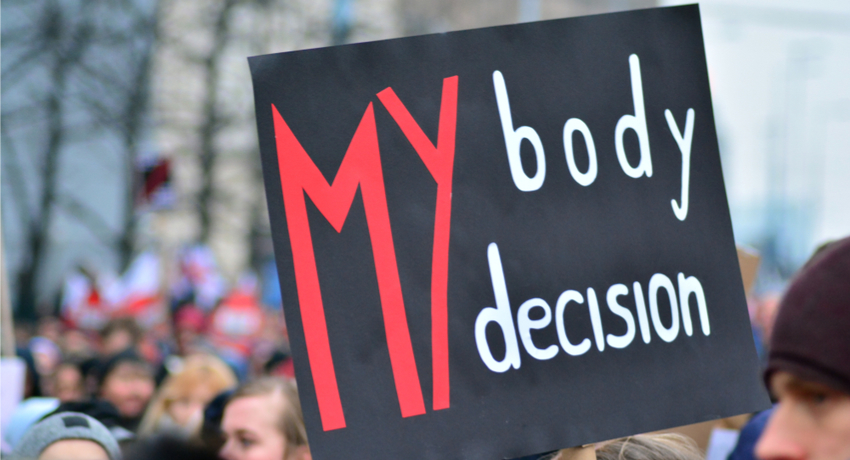The portrayal of abortion in the media can sway public perception in a major way, and can even influence policy agendas. When this media focus is honest and accurate, it has the potential to arouse global outrage at violations of women’s rights.
We saw this amid media coverage of Savita Halappanavar’s death in 2012, after she was refused an abortion in Ireland despite life-threatening pregnancy complications. Public outrage over this case helped to mobilise people in their demands for a referendum on Ireland’s restrictive abortion law, which is now set for May 25th.

Dublin, Ireland: 6th Annual March for Choice, September 2017
More recently, Brazil’s congress was set to vote on a constitutional amendment including a clause which could effectively ban abortion in all cases; currenty it is legal only in cases of rape, fetal anomaly, or to save a woman’s life. The media played a vital role in documenting the social movement against the proposed motion; the vote has been repeatedly postponed.
Even progressive journalists inadvertently pick-up and repeat anti-abortion myths, language and imagery
Journalists can be co-workers in the fight for abortion rights. Yet, a recent series of interviews with more than 30 journalists in the US found that they face stigmatisation and political opposition when seeking to report positively on abortion. This can mean that even progressive journalists inadvertently pick-up and repeat anti-abortion myths, language and imagery.
Working with the International Campaign on Women’s Right to Safe Abortion, I encounter common media mistakes daily. Many journalists, for example, feel that they must present the anti-abortion argument alongside the pro-choice case, in the name of balance.
Denying women human rights is not neutrality
When the Chilean Congress voted to ease its abortion ban last year, reporters interviewed both pro-choice and anti-abortion groups in attempts to show neutrality. But the pro-choice viewpoint is inherently balanced; it respects each woman’s right to decide what’s best for her. Denying women human rights is not neutrality.
Reporters often dramatise cases to make stories newsworthy, sometimes unintentionally repeating misconceptions around abortion.
A 2010 analysis of seven British and five Scottish national newspapers found that abortion was repeatedly presented as physically and emotionally risky. This is false: World Health Organisation research shows that abortion is one of the safest surgical procedures when performed by trained persons. This also applies to the self-administration of medical abortion pills.
The media should focus on the scandal of states refusing to make abortion safe, forcing pregnant women to turn to life-threatening options
Rather than exaggerating the harms of safe abortion methods, the media should focus on the scandal of states refusing to make abortion safe, forcing pregnant women to turn to life-threatening options. Powerful journalism has explored, for example, the highly restrictive Senegalese abortion law and the imprisonment of women who have had unsafe abortions.
Abortion does not cause mental health problems. But being denied an abortion and forced to carry an unwanted pregnancy to term can damage anyone’s mental state. A study of more than 200 children in Prague in the 1960s found that being unwanted in early pregnancy was also associated with psychological problems in children.
Well-meaning journalists often use misguided language. Terms like pregnant woman and fetus should be used rather than mother and baby.
Media from Armenia, China and India frequently speak about ‘aborting girls’ in regard to sex-selective abortion. Sex-selection is an outcome of discriminatory cultural norms; coverage should thus focus on sex discrimination, not abortion.
Progressive media coverage should use imagery that emphasises abortion as ordinary healthcare
Another common problem in progressive and positive abortion-related articles is the use of inaccurate images, usually inserted by an editor. Many media reports celebrated Sierra Leone’s parliament voting to remove its 150-year-old colonial abortion law. However, articles were supplemented by ill-informed imagery, such as heavily pregnant bellies, or fetuses detached from bodies.
A graphic focus on late-term abortion can generate a wrongful perception that is in turn used to spearhead calls to restrict women’s access to these services. Most abortions take place in the first trimester.
Progressive media coverage should use imagery that emphasises abortion as ordinary healthcare (such as images of medical professionals or abortion pills), or highlights the pro-choice movement. The Women’s March in the US, and the Black Monday protest in Poland, produced empowering images of activists fighting for changes to abortion legislation, in favour of women’s rights.

Krakow, Poland: Protest against a legislative proposal for a total ban of abortion, October 2016
Finally, journalists frequently seek personal experiences of those who have had an abortion to powerfully illustrate what’s at stake. However, abortion rights are also a collective issue; the case for these rights cannot rest on an individual story. Media coverage should reflect the complexities of abortion experiences, including among adolescents, trans people and married women with children.
Ill-informed media stories can eclipse the truth about abortion in public and political arenas. It is essential that journalists stick to facts and normalise the experience; one in four women globally will have an abortion in her lifetime.
Importantly, I do encounter thought-provoking media on a daily basis which demonstrates the vivacity of the pro-choice movement and its strength in tackling the backlash against women’s rights. This will gradually influence discourse around the need to decriminalise abortion, and reduce the need for unsafe abortions.
This article was first published on openDemocracy 50:50 and has been reproduced here under the Creative Commons Attribution-NonCommercial 4.0 International licence. Read the original here.




